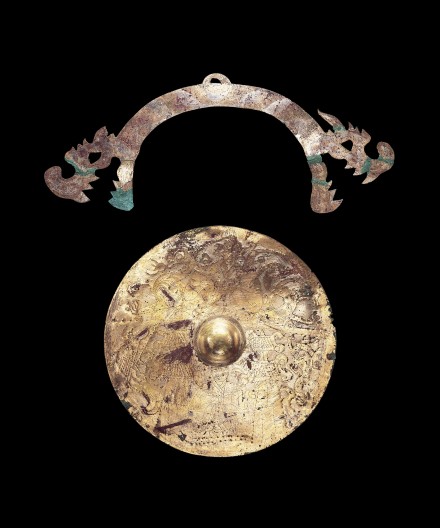J.J. Lally & Co., Oriental Art / New York City, New York
MenuPast Exhibition
Bronze and Gold in Ancient China
March 24 - April 12, 2003

24.
A GILT BRONZE DRAGON-HEAD HUANG AND A BI DISC
Eastern Han Dynasty, A.D. 2nd -Early 3rd Century
the wide arc-shaped huang ending in silhouetted dragon heads with large pierced eyes and wide open jaws showing jagged teeth, engraved with linear details including spiral stripes on the body and 'C'-scroll motifs on the head, the thin metal with a silvered surface, highlighted with gilding on the stripes, around the margins and on other details including the central suspension loop; the large bi disc with a small central aperture covered by a domed boss over a spike for attachment, very freely engraved in the upper half of the disc with a figure of Xiwangmu, the Queen Mother of the West, seated with a dragon on her left and a winged tiger on her right above twin towers representing the Gates of Heaven, flanked by a large three-legged bird and a winged tiger, and with a guardian deity in the center, blocking the gateway, shown dressed as a court dignitary but with a feathered cape over his shoulders, the scene outlined in dotted lines and highlighted in gilding over a silvered background, with a plain gilded border around the edge, showing some bright green corrosion from burial.
Huang: Length 16 1⁄2 inches (42 cm)
Disc: Diameter 10 5⁄8 inches (27 cm)
The figure shown on the upper half of this disc, Xiwangmu, the Queen Mother of the West, was the most important deity in the cult of heaven, one of the oldest of all Chinese religious ideas. The Queen Mother is identified by her crown and costume and by the auspicious animals guarding her throne. She was known as the Queen Mother of the West because of the belief that she presided over a heavenly realm located in the far west, on top of Mount Kunlun.
A gilt-bronze ornamental disc engraved with a different rendering of the same themes, including the two characters tian men (gate of heaven) inscribed between the towers on the lower half, was among a group of gilt-bronze ornaments discovered in brick tombs in eastern Sichuan province during archaeological work in 1982-1987 and is published in a line drawing in Kaogu 1998, No. 12, p. 81, fig. 1, in a report entitled Chongqing Wushanxian Dong Han liujin tongpaishi de faxian yu yanjiu (Discovery and investigation of Eastern Han gilded bronze ornamental plaques from Wushan county, Chongqing), together with ten other discs and four other engraved gilt bronze panels of various shapes. The same disc, together with four of the other ornamental plaques from the same source, is illustrated in a line drawing in the exhibition catalogue, Ancient Sichuan: Treasures from a Lost Civilization, R. Bagley ed., Seattle 2001, p. 54, in an introductory essay by Michèle Pirazzoli-t'Serstevens entitled "Sichuan in the Warring States and Han Periods", with an excellent summary of the belief systems and burial customs in Western China during the Eastern Han period, pp. 50-57.
Compare also a gilt and silvered bronze disc engraved with the same motif in the Royal Ontario Museum, Toronto, received as a donation from the Tanenbaum Collection together with several other similar Eastern Han mortuary ornaments, illustrated by Klaas Ruitenbeek in the exhibition catalogue entitled Chinese Shadows, Toronto, 2002, cat. no. 13C, p. 28, with a full caption on p. 57.
24.
A GILT BRONZE DRAGON-HEAD HUANG AND A BI DISC
Eastern Han Dynasty, A.D. 2nd -Early 3rd Century
Huang: Length 16 1⁄2 inches (42 cm)
Disc: Diameter 10 5⁄8 inches (27 cm)